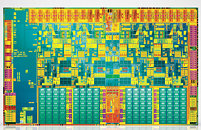- Joined
- Oct 9, 2007
- Messages
- 47,315 (7.52/day)
- Location
- Hyderabad, India
| System Name | RBMK-1000 |
|---|---|
| Processor | AMD Ryzen 7 5700G |
| Motherboard | ASUS ROG Strix B450-E Gaming |
| Cooling | DeepCool Gammax L240 V2 |
| Memory | 2x 8GB G.Skill Sniper X |
| Video Card(s) | Palit GeForce RTX 2080 SUPER GameRock |
| Storage | Western Digital Black NVMe 512GB |
| Display(s) | BenQ 1440p 60 Hz 27-inch |
| Case | Corsair Carbide 100R |
| Audio Device(s) | ASUS SupremeFX S1220A |
| Power Supply | Cooler Master MWE Gold 650W |
| Mouse | ASUS ROG Strix Impact |
| Keyboard | Gamdias Hermes E2 |
| Software | Windows 11 Pro |
Intel Corporation today disclosed new information about next-generation Intel Xeon processors - codenamed "Jasper Forest" - for communications and storage applications, due in early 2010. With Jasper Forest, Intel engineers have, for the first time, integrated PCI Express (PCIe) in a dual-processing Xeon processor, which greatly facilitates dense storage and communications solutions such as IPTV, VoIP, NAS, SAN and wireless radio network controllers.
Jasper Forest maintains the outstanding performance of Intel architecture (Nehalem), while lowering system power consumption by 27 watts when compared to the Intel Xeon 5500 series processors. The dual-processing solution integrates two Jasper Forest processors with 16 PCIe Generation 2.0 lanes each and is paired with the Intel 3420 chipset platform controller hub. This integration of the I/O hub via PCIe enables significant power and space savings, resulting in one of the highest performance-per-watt Intel Xeon chips ever.

Jasper Forest provides a scalable option to design with a single-core, 23-watt processor to a quad-core, 85-watt processor using the same socket. The interoperability of Intel architecture can alleviate the frustration of costs and headaches associated with using different architectures. For example, as telecommunications providers are known to employ up to 10 different architectures, Jasper Forest's leading performance-per-watt would allow them to consolidate system designs onto one common architecture and platform.
Additional technical features of Jasper Forest include:
The processors, expected to be available by early 2010, will be offered to customers with 7-year lifecycle support and are ideal for applications in market segments such as communications, storage, wireless infrastructure, routers, military and security.
View at TechPowerUp Main Site
Jasper Forest maintains the outstanding performance of Intel architecture (Nehalem), while lowering system power consumption by 27 watts when compared to the Intel Xeon 5500 series processors. The dual-processing solution integrates two Jasper Forest processors with 16 PCIe Generation 2.0 lanes each and is paired with the Intel 3420 chipset platform controller hub. This integration of the I/O hub via PCIe enables significant power and space savings, resulting in one of the highest performance-per-watt Intel Xeon chips ever.

Jasper Forest provides a scalable option to design with a single-core, 23-watt processor to a quad-core, 85-watt processor using the same socket. The interoperability of Intel architecture can alleviate the frustration of costs and headaches associated with using different architectures. For example, as telecommunications providers are known to employ up to 10 different architectures, Jasper Forest's leading performance-per-watt would allow them to consolidate system designs onto one common architecture and platform.
Additional technical features of Jasper Forest include:
- Non-transparent bridging functionality allows multiple systems to seamlessly connect over a PCIe link, removing the need for an external PCIe switch.
- Integrated Redundant Array of Independent Disks (RAID) acceleration, which is advantageous for storage customers migrating to Intel architecture or transitioning RAID for core optimization.
- Integrated Asynchronous Dynamic Random Access Memory Self-Refresh memory provides a backup solution to help protect critical data in the event of a power failure.
The processors, expected to be available by early 2010, will be offered to customers with 7-year lifecycle support and are ideal for applications in market segments such as communications, storage, wireless infrastructure, routers, military and security.
View at TechPowerUp Main Site


